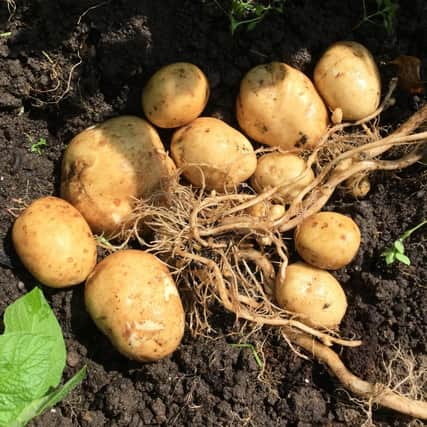GARDENING: Tatties and toms are garden favourites


We`ll start harvesting one this weekend as tradition dictates, the other will deliver a little later. Both continue cropping throughout summer so, let’s hear it for Solanum tuberosum and Lycopersicon esculentum. They`re potatoes and tomatoes of course, now part of our year-round staple diet but it was a totally different story when they first arrived in Britain. Potatoes were introduced in the late 16 th century but were initially of more interest to botanists and collectors than market traders. The herbalist John Gerard was growing them in his London garden and wrote in 1597 that they were small and knobbly.
Interestingly, he also recorded that the leaves were poisonous, as were the roots when exposed to light.
Advertisement
Hide AdAdvertisement
Hide AdWhen potato tubers are subjected to sunlight, they develop green patches, if they are then consumed by accident, they will at least cause a severe stomach upset. Avoid this by deep planting, earthing up soil from between the rows, and checking for exposed tubers as the plants grow.
There`s a similar risk from eating green tomatoes and the fruits of aubergine (egg plant) when not fully ripened. This is not surprising given that all three plants belong to the family Solanaceae, the most infamous member being Atropa belladonna (deadly nightshade).
A far cry from the early days, thanks to hybridists and improved methods of cultivation, potatoes are now in year-round demand. An estimated 7 million tons per annum are grown by Britain`s farmers, and an average 200 lbs of those are eaten by each of us every year.
Although there are over 700 varieties in existence, our choice when buying at the supermarket is limited, and when sourcing seed potatoes to grow your own, expect to find a dozen or so first early cultivars on display. This means that if you`ve seen a slightly offbeat variety on display at a show and have difficulty in sourcing it, best option is to search online for a specialist supplier.
Advertisement
Hide AdAdvertisement
Hide AdWhether you`re growing potatoes in the garden, or a container, watering is a key factor. Avoid cultivating them on the same piece of land each year to prevent a build-up of plant-specific pests and diseases.
Currently, my first earlies have healthy green foliage, but I`m mindful that this is a critical stage in their growth cycle. Spores of potato blight take to the air and head north in July. First sign of attack is the drooping of leaves on a single plant in the heart of an otherwise healthy group. Immediate action is required.
Remove the complete haulm and dispose of it carefully. Not in the composting facility. Now`s the time to consider planning a yuletide treat, by ordering potatoes to start growing in a container from late September.
Love apples was the affectionate name given to tomatoes when they first appeared on the European gardening scene. Some saw the fruits as heart-shaped, therefore an aphrodisiac, and interest grew. In keeping with the earliest potatoes, they too were native to South America and far removed from the range of delicious choice of cultivars we enjoy today. Originally grown
Advertisement
Hide AdAdvertisement
Hide Adas ground trailing plants in their native land, they are now trained to grow skyward on a diversity of structures, my choice being canes.
They grow best in the well-lit, controlled environment of a greenhouse, but an indoor window ledge, space on the patio or open garden, are options that can also work. Apart from the usual greenhouse crop, we have three separate groups growing in sunny parts of the open garden.
There`s no question that cultivating a decent tomato crop presents a challenge. It demands constant attention, watering plants twice daily at the height of season, feeding at weekly intervals once the first truss of fruit has set, tying to supports as they grow and pinching out shoots that develop in leaf joints.
There are more than enough pests and diseases to look out for. Aphid, whitefly, and red spider love hot, dry conditions, so we control the greenhouse environment accordingly. Stem and root rot diseases, even viral types can appear, but preventive hygiene will help avoid them. There`s a higher risk of root problems if a crop is grown year on year in the same border soil but pot-
Advertisement
Hide AdAdvertisement
Hide Adculture can obviate this. However, all these potential hazards have to be measured against the thrill of walking into the summer greenhouse, picking a home-grown, cherry-sized `Gardener`s Delight` and popping it in your mouth. Bliss!
Footnote: Potatoes, tomatoes, aubergine, and Deadly nightshade all belong to the same family (Solanaceae). Unripe tomatoes and unripe aubergine can cause a severe stomach disorder. Green potatoes are poisonous and deadly nightshade is certainly so.